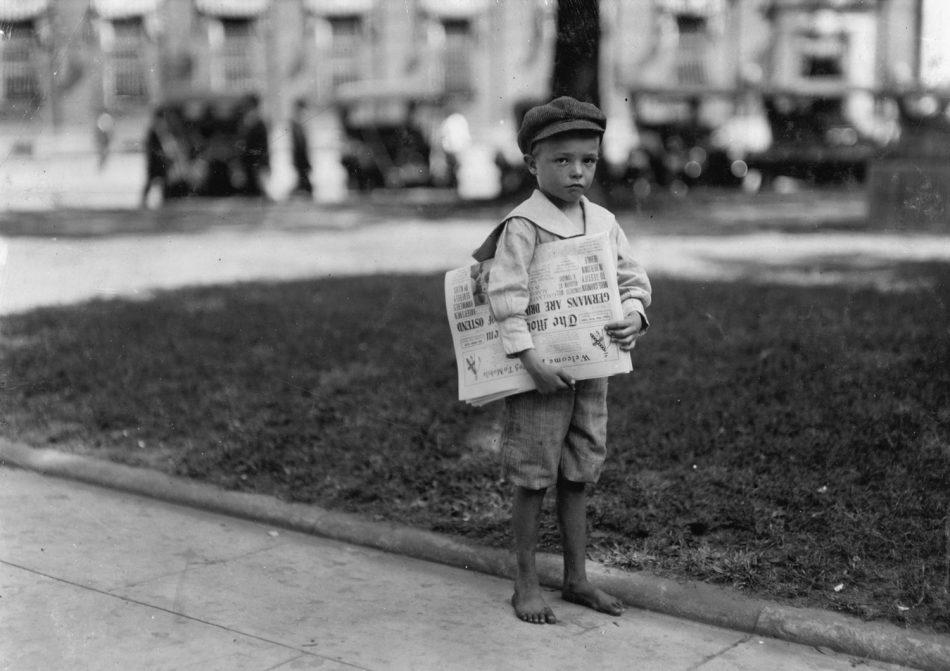
Page Description
Explore the history, current issues, and impact of child labor in the US, including the laws, challenges, and efforts to protect vulnerable children.
1 Child Labor in America
2 Child Labor in the Industrial Revolution – Video Infographic
3 Child Labor and Lewis Hine — Pt. 1
6 jan. 2010


“Lewis Hine and His battle Against Child ‘Slavery’”
Based upon an article written by Jennifer L. Peresie
From the magazine “Pennsylvania Heritage”
An investor from Atlanta, Georgia declared,
“The most beautiful sight is the child at labor; as early as he may get at labor the more beautiful, the more useful does his life get to be.”
The stories which people heard seemed incredible. Businessmen procliamed that child labor wasn’t wrong
while men in white collars wouldn’t admit the problem existed. They claimed that destitute mothers and widows needed the income that was provided by their employed children. Child labor became a problem in the United States during the Industrial Revolution when machinery was invented that was so simple to operate a child could perform the given task.
The plight of these children was documented by reformer – photographer Lewis Wickes Hine (1874 – 1940). He wasn’t received graciously by foremen and company police. Frequently, he was refused entrance into the workplace throughout his crusade to document the exploitation of children. In fact, children were often hidden from his sight in the attempt to deceive Hine. Hine would pose as a fire inspector, an insurance salesman, a Bible salesman, an industrial photographer, any masquerade that would gain entry to the workplace of the children he desired to help.
American businessmen fervently asserted that they could not continue to operate without child labor. Throughout the Industrial Revolution, children provided a source of cheap inexpensive labor and a source of large profits.
Why pay a father seven dollars a week when one can conveniently play a child two dollars a week. Consequently, a father would be replaced in the work place by his children. For a family to survive the remaining children would also be employed to offset and balance the father’s loss of income. The children became wage-earners in some families. Parents would purchase work permits which circumvented laws that regulated the minimum age for employment. Tragically, children as young as five years were issued permits to work. Receiving an education was considered a ‘waste of time’ by some uneducated parents as well as employers. In the clothing mills of the south, every fourth employee was between the ages of 10 and 15. It is heart-rending to discover that many of those children employed in southern mills were even younger.
According to the census of 1900, most of the 25,000 boys employed in the mines and quarries were in Pennsylvania. In 1911, there were 2 million children under the age of 16 in the American workforce. In the anthracite coal industry children worked as breaker boys, separating coal from slag, mule drivers, runners, and gate tenders.
In 1910, little girls worked at dangerous machines knitting stockings for long hours in poorly lighted, lint filled textile mills.
Thousands of blowers’ assistants were employed in the glass making industry. The children of America worked as sweepers, spinners, and doffers in the textile mills. Children worked in canneries and farms beside their parents. ‘Little merchants,’ hawked produce and sold an assortment of items on the streets of American towns and cities.
Children worked six days a week from six in the morning till eight o’clock at night. There was neither time for education nor play but only time to eat and sleep after returning home.
Children were employed working in mines, quarries, textile mills, canneries, farms, the glass industry, and virtually every field of employment. Small hands enabled breaker boys in the mines to swiftly sort and size coal in collieries. Employers threatened children to work harder or lose their jobs.
“Haggard, hungry, and faint after the night’s work…three cents an hour she got for her surrender of sleep and strength, play and study…” wrote American poet Edwin Markham (1852 – 1940).
Children worked in dusty lint-filled rooms in the textile mills and coal mine tunnels laden with heavy coal dust particles. Those unfortunate children risked developing a variety of respiratory diseases.
Children in the workplace faced various dangers to their health and safety without the protection of healthcare and insurance. In an attempt to increase productivity and save money, machines were made unsafe to operate when employers removed safety guards. Children suffered from respiratory diseases from pollutants in the air. The open furnaces of glass factories produced intense heat and glare. These conditions resulted in eye disorders, lung ailments and heat exhaustion from exposure to the heat of open furnaces.
Consequently, nearly all children in the labor force were underdeveloped in weight, height and girth of chest. Dr. Elizabeth Shapleigh made the following declaration following her own personal observations:
“A considerable number of these boys and girls die within the first two or three years after beginning to work. Thirty-six out of every hundred men and women in the mill die before or by the time they are twenty-five years of age.”
Regrettably, child labor laws were weak and so was enforcement of those laws for there were no generally accepted standards.
Disheartened at the sight of child laborers, Rabbi Steven Wise of New York retorted:
“We [the United States] have laws that we find are no laws and we have enforcement that we find is no enforcement.”
Working children had no time for an education at school. Alexander J. McKelway boldly declared that child labor would eventually lead to:
“racial degeneracy, perpetual poverty, the enlargement of illiteracy, the destruction of democracy, the disintegration of the family, the increase of crime, the lowering of the wage scale, and the swelling of the army of the unemployed.”
The National Child Labor Committee began its crusade in 1904 against enormous child labor evils. Felix Adler would eventually become president of the NCLC. He articulated the urgent need to create a national body that was focused on child labor. At the first meeting of the NCLC, he put forward the purpose of the NCLC which,
“shall be a great moral force for the protection of children. It is to combat the danger in which childhood is placed by greed and rapacity. Cheap labor means child labor; consequently, there results a holocaust of the children – a condition which intolerable… The Committee thus becomes a great moral force to prevent the relapse of whole communities in the barbarous conditions which we now see.”
The forty members of the National Child Labor Committee (NCLC) fought tirelessly for years against the inhumanity and document the problems of child labor. The creation of the NCLC became a significant event during the “Progressive Era.”
They campaigned tirelessly for a minimum age of fourteen to work in manufacturing and sixteen in the industry of mining. They also fought for a maximum work day of eight hours and no work at nights for children under the age of sixteen.
The membership secretary of the NCLC was Josephine Eschenbrenner who declared:
“There is no future for the child laborer – no future except the human junk heap.”
The National Child Labor Committee realized they needed a photographer to document visually the harsh child labor conditions in the American workplace.
Lewis Hine had become a photographer five years earlier to document the activities of New York’s Ethical Cultural School where he taught geography at the school. In the attempt to dispel prejudices, Hine photographed immigrants as they arrived at Ellis Island. He realized that photography could be a valuable tool to help reform society. He became a master photographer and his photographs were published on the cover of magazines.
After accepting the task of documenting the injustice of child labor, Hine declared, “I felt I was merely changing my educational efforts from the classroom to the world.”
Photographer Walter Rosenblum was a friend of Lewis Wickes Hine (1874 – 1940). Rosenblum explained why Hine accepted the task of documenting the crime of child labor:
“he regarded his work as a moral responsibility. He wanted many people to see his photographs; he wanted to educate the entire country. His ambition was to be a social photographer, a photographer who documented how people lived and made a living and especially the problems of children. He was a warm and lovely man and did not understand at all how it was possible for kids to work twelve or fourteen hours a day for very little pay…He just had a need to do that kind of photography.”
American authors had described the abominations of child labor but the American public found the stories too difficult to believe. Lewis Hine wanted to show the American public the truth while mobilizing public opinion.
“I try to do with the camera what the writer does with words.” Furthermore, he declared: “People can be stirred to a realization of the values of life by writing. Unfortunately, many persons don’t comprehend good writing. On the other hand, a picture makes it appeal to everyone.”
Lewis Hine ‘battled like a warrior to end the terrible exploitation of children.’
Hine was one crusader who went into combat with the social ill of child labor. He systematically documented in a small notebook every photograph with precise facts. He measured children by using the button on his coat. Hine recorded names, ages, the hours worked, earnings, schooling, and various facts about each child he photographed.
“..all along I had to be double-sure that my photo data was one hundred percent pure – not retouching or fakery of any kind,” he declared.
The adult factory workers verified and attested to the accuracy of Hine’s work. One woman confirmed the authenticity of his photographs:
“They are exactly like the things I saw when I worked in the mills and factories; those things which break boys and girls and leave a mark upon them.”
To Hine and the members of the National Child Labor Committee employers did not desire to acknowledge the child labor problems which existed. Hine wanted the American public to see his photographs but businessmen asserted that child labor was neither wrong nor widespread.
“I cannot understand,” Hine said, “how is it that directors, superintendents, and other interested parties with ordinary eyes in their heads can see these tiny, immature children coming and going four times a day, and then say they do not have violations of the law!”
His photographs were published in newspapers, magazines, and exhibits of the NCLC which added significance to words. Hine would lecture on the conditions of child labor wherever he traveled. He designed pamphlets, booklets, and photographic exhibitions to inform people of the travesty of child labor.
His photographs speak for themselves and accomplish what he set out do to which was to document the plight of children in the workplace. They show graphic proof that American employers were exploiting children.
The photographs shocked, angered, and galvanized people to stand against this form of industrial child abuse which was what Hine desired to take place. He wrote to Frank Murray, superintendent of the Ethical Culture School, as early as 1910 declaring:
“I am sure I am right in my choice of work. My child labor photos have already set the authorities to see if such things are possible.”
A newspaper reporter was attending a conference in Birmingham, Alabama, where he saw an exhibit of Hine’s photographs. The reporter was stunned by the clout of Lewis’ Hine’s photos.
“There has been no more convincing proof of the absolute necessity of child labor laws than these pictures showing the suffering, degradation, the immoral influence, the utter lack of anything that is wholesome in the lives of these poor little wage earners. They speak far more eloquently than any [written work] – and depict a state of affairs which is terrible in its reality – terrible to encounter, terrible to admit that such things exist in civilized communities.”
“These pictures speak for themselves,” declared the NCLC, “and prove the law is being violated.”
The former president of the NCLC was Owen Lovejoy. He would later tell Hine:
“The evils inherent in the system were intellectually, but not emotionally recognized until your skill, earnestness, and devotion, vision and artistic finesse focused the camera intelligently, sympathetically and effectively on social problems involved in the American industry.”
Ann Healey, of Middleboro, Massachusetts worked as a spinner at the Star Mill in her hometown. Jennifer L. Peresie interviewed the one hundred and two year old woman in February of 1996. Ann Healey spoke of recollections of what life was like as a young laborer in the workforce. Ms. Healey recalled how happy she was when investigators, working to end the abuses of child labor, visited the mills. Ann Healey “felt that Lewis Hine had been successful in what she believed was one of the most important causes, the fight against child labor,” according to Ms. Peresie.
Annie Healey remembered when Lewis Hine came to the mill where she worked to take photographs.
“He came in and said he wanted to take some pictures of the machines but he had a lot of us kids stand by them. Later, my mother told me he was Lewis Hine. She was excited because this man had helped people see why child labor was bad in other states and she thought maybe he’d do something here. She was right! For some reason, suddenly, the law-makers considered our child labor an important problem.”
Jennifer Peresie also interviewed Walter Rosenblum of New York, a confidant and close friend of Lewis Hine. Rosenblum carefully explained why Hine took the assignment of photographing children in the workforce for the NCLC. Rosenblum declared that Hine “wanted to be a ‘social photographer’ from the first day he used a camera.”
Hine’s true contribution to the crusade against child labor is incalculable as was his influence to the adoption of laws protecting children. There is no doubt that he mobilized public opinion.
Those persons who saw Hine’s photographs want to either abolish child labor or severely restrict the use of it. A man from Newark, New Jersey saw the photos and volunteered: “Is there not something I can do to help? I have looked at these pictures and I want to help.”
Hine’s pictures brought attention to the problems of child labor swaying public opinion in support of new legislation.
By 1919, laws were enacted in New Jersey, Indiana, and West Virginia prohibiting children under the age of sixteen from night work. Pennsylvania passed legislation which would protect children under the age of twelve from working late hours.
Legislation establishing compulsory education was passed in every state which limited child labor. Alabama’s legislature changed state child labor laws through Hine’s personal direct persuasion.
A senator made the following remark during the Seventh Annual Conference on Child Labor in 1911:
“From you [Hine] we learn that the child is our most precious, priceless product and should not be exploited…We now think keenly alive to the necessities for a better child labor law.”
The American public dramatically voiced their opinion for Congress to pass two federal child labor laws. The first of these laws was passed in 1916 and the second in 1918. The laws were poorly written and subsequently the Supreme Court of the United States overturned these laws and ruled that they infringe the 10th Amendment protection of the rights of states.
Slavery was abolished in 1865 but heartbreakingly child slave labor continued through the 1920s!
A Constitutional Amendment was approved by Congress in 1924. The federal government would regulate the labor of workers younger than eighteen years of age. The amendment was viciously attacked by members of the news media and press promoting fear of an overpowering federal government. Tragically, the amendment failed to be ratified by three fourths of the states. Almost two decades would pass before federal restrictions upon child labor were passed into legislation.
In 1938, two years before the death of Lewis Hine, Congress enacted the Fair Labor Standards Act.
Jeffrey Newman, current president of the NCLC made this declaration almost fifty years after the death of Lewis Wickes Hine:
“He impacted the lives of millions of children during his lifetime to this very day.”
Lewis Hine’s friend Walter Rosenblum declared,
“Each fragile personality seems strangled by the environment, making it clear why Hine’s photographs were considered the single most important voice – He is considered the most extensive and successful photo-grapher of social welfare work…First, his photographs and his documentation about what he discovered showed the truth.”
4 Child Labor and Lewis Hine — Pt. 2
6 jan. 2010
5 Breaker Boys
6 jan. 2010
6 Child Labor in America: The photography of Lewis Hine.
4 nov. 2014





 ️
️7 Child Labor Reform in the Progressive Era
2 mei 2020
8 La belle-mère pousse la mariée !



Jade
5 maanden geleden